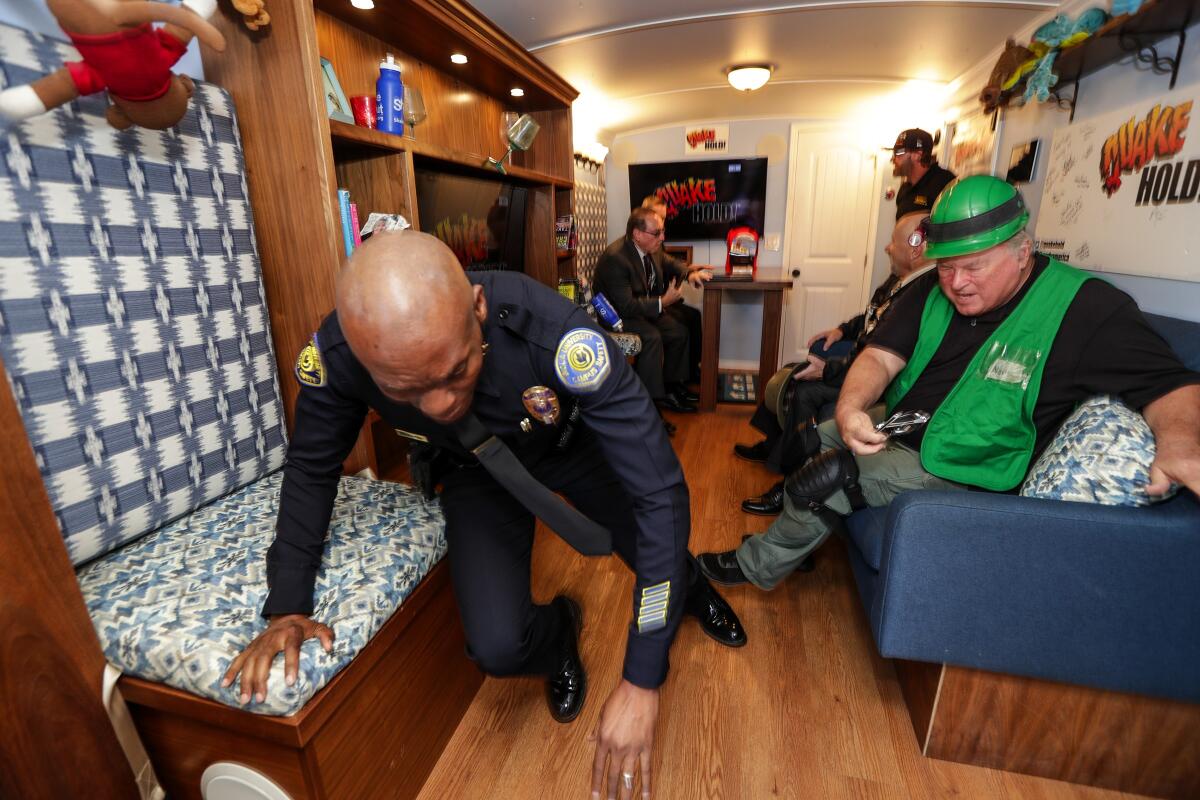UC Irvine tests new technology to help seniors during Thursday’s California ShakeOut

- Share via
What do you do when there’s an earthquake?
Drop, cover and hold on, says the Earthquake Country Alliance, a “public-private-grassroots” partnership made up of people, organizations and regional alliances geared around raising disaster preparedness in the face of earthquakes and tsunamis.
For the record:
11:03 a.m. Oct. 19, 2022A previous version of this story identified the retirement community as Walnut Creek. It is Walnut Village.
Orange County residents may receive text alerts Thursday morning, encouraging them to do just that and take cover as part of the statewide Great California Shakeout.
First staged in Southern California by the U.S. Geological Survey in 2008, it returns at 10:20 a.m. Thursday, when about 9.4 million people statewide will participate in the earthquake drill. Of that, an estimated 865,820 people in Orange County will take part.
That includes about 5,000 childcare and preschools, 510,000 schools, 47,000 local government bodies and 6,000 senior facilities.
And at one of those senior living facilities, administrators and a team of computer science researchers from UC Irvine will be working to put into practice a new technology alongside the drill that they say will provide critical information for care and locating senior patients in the event of an emergency and evacuation.
“Over the years, I ... and our team [have] been doing a lot of work with disaster response awareness and one of the things that we came across was, especially with the COVID-19 pandemic, that if you look at disasters of any kind older adults are disproportionately impacted,” said Nalini Venkatasubramanian, a professor of computer science at UC Irvine.
Venkatasubramanian said the issue was often that seniors tended to not get the care that they needed after evacuations, noting that people who were oxygen-tank dependent or required dialysis could not simply be evacuated to a school gym, for example, where power could potentially go off.
The idea for “CareDEX” was born. The technology was developed by Venkatasubramanian and Nikil Dutt, a distinguished professor of computer science, Sharad Mehrotra, a chancellor’s professor of computer science, Lisa Gibbs, a clinical professor of geriatrics, and geriatrics project scientists.
“The idea was creating information preparedness, which allows us, senior care facilities, first responders, the government and other stakeholders to keep track of priorities and needs of the older adults. That includes conditions like dementia, oxygen-dependence, [diabetes] — these are the kinds of conditions that need attention,” Venkatasubramanian said. “You can’t say come back a month later and take care of it.”
Venkatasubramanian and her team have been collaborating with the city of Anaheim’s emergency manager Jannine Wilmoth and the Walnut Village retirement community to pilot CareDEX over the last year.
“From an operator’s standpoint, ... these human beings are all ultimately my responsibility,” Debbie Infield, executive director of Walnut Village, said in an interview Tuesday. “Knowing where they are is half the battle.”
Infield said the software, which can help provide information on patients’ schedules and track where residents were last seen through WiFi-enabled tags or devices, can help her or first responders find the patients to get them the help that they might need.
“Disaster preparedness is as critical as response,” Venkatasubramanian said. “If ... people do not know how to use the technology, they may not know how to use it during a disaster. Constantly embedding it in a dual-use process is a very useful thing to do because people are then used to it.
“The other thing is practice, practice, practice. These kinds of exercises are vital for people to understand what could go wrong and be able to anticipate and prepare for what might go wrong. I think it creates an awareness in the community. If I send out alerts and messages, it might not work for ... [the] blind. Saying, ‘Hey, evacuate,’ but maybe there is someone on the third floor or in a wheelchair.”
Venkatasubramanian said having a “one size fits all” approach doesn’t always work, especially for the elderly and disabled.
“Today, we have some technological ability to do this and the challenge is how do you make it accessible to everybody? ... I think there is a way to be prepared and we want to make citizens aware of that — that disaster preparedness is critical because disasters are more frequent now. You want to know where your loved ones are; you want to know they’re taken care of and people have information as to how to keep them safe.
“A lot of this can be done before the disaster,” she said. If people are prepared and have plans for what they’ll do in an emergency they can “develop the memory of what to do when a disaster occurs and that can help improve the outcomes,” she said.
All the latest on Orange County from Orange County.
Get our free TimesOC newsletter.
You may occasionally receive promotional content from the Daily Pilot.










